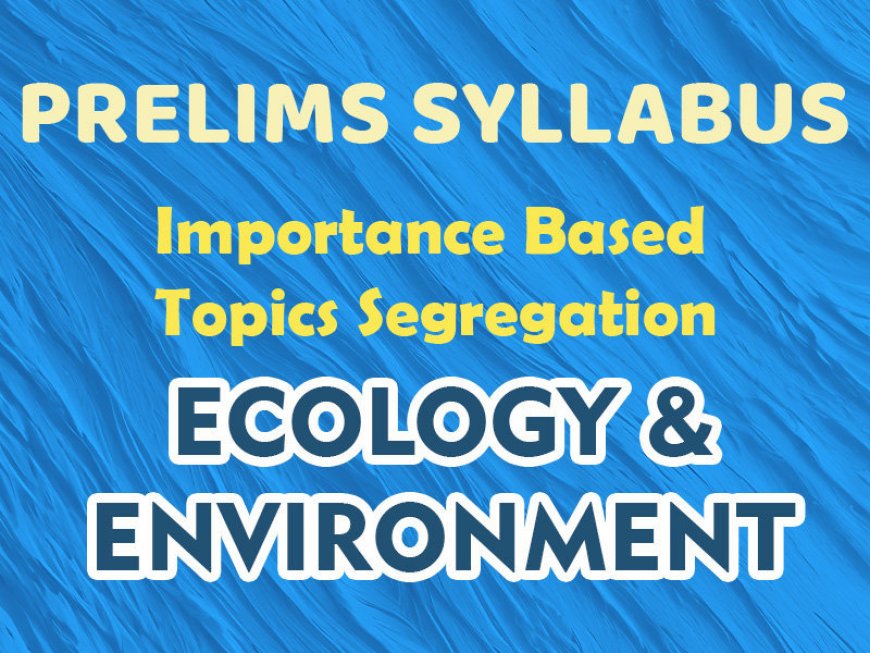Pre - Syllabus - Importance Based - Ecology & Envieronemt
Pre - Syllabus - Importance Based - Ecology & Envieronemt

· Basic Concepts of Ecology (9-11)
o Levels of Organization (3-5)
§ Individual, population, community, ecosystem, biome, biosphere
o Energy Flow in Ecosystems (5-7)
§ Food chains and food webs
§ Trophic levels
§ Ecological pyramids
· Biogeochemical Cycles (5-7)
o Water Cycle (1-3)
o Carbon Cycle (3-5)
o Nitrogen Cycle (3-5)
o Phosphorus and Sulphur Cycles (1-3)
· Ecosystem Types and Functions (7-9)
o Terrestrial Ecosystems (3-5)
§ Forests, grasslands, deserts
o Aquatic Ecosystems (3-5)
§ Freshwater, marine, wetlands
o Ecotones and Edge Effects (1-3)
· Biodiversity Concepts (7-9)
o Levels of Biodiversity (3-5)
§ Genetic, species, ecosystem diversity
o Biodiversity Hotspots (5-7)
§ Criteria and global hotspots
§ Hotspots in India
· Threats to Biodiversity (7-9)
o Habitat Loss and Fragmentation (3-5)
o Invasive Species (3-5)
o Poaching and Wildlife Trade (3-5)
· Conservation Efforts (15-17)
o In-situ Conservation (7-9)
§ National parks, wildlife sanctuaries, biosphere reserves
§ Sacred groves
o Ex-situ Conservation (5-7)
§ Zoos, botanical gardens, seed banks
o Conservation Projects (5-7)
§ Project Tiger, Project Elephant, Rhino Conservation
· Air Pollution (7-9)
o Sources and Types of Pollutants (5-7)
§ Particulate matter, NOx, SOx, ozone
o Effects on Health and Environment (5-7)
§ Respiratory issues, acid rain, smog
o Control Measures (5-7)
§ National Air Quality Index
§ Pollution control technologies
· Water Pollution (7-9)
o Sources of Pollution (5-7)
§ Industrial effluents, sewage, agricultural runoff
o Eutrophication (3-5)
o Water Quality Standards (3-5)
· Soil Pollution and Degradation (5-7)
o Causes (3-5)
§ Overuse of fertilizers and pesticides
§ Industrial waste disposal
o Soil Conservation Methods (3-5)
§ Contour ploughing, afforestation
· Solid Waste Management (5-7)
o Types of Solid Waste (3-5)
§ Municipal, industrial, hazardous
o Waste Disposal Methods (3-5)
§ Landfills, incineration, composting
o Plastic Waste Management (3-5)
· Causes of Climate Change (9-11)
o Greenhouse Gases (5-7)
§ CO₂, CH₄, N₂O, fluorinated gases
o Anthropogenic Activities (5-7)
§ Fossil fuel combustion, deforestation
· Impacts of Climate Change (9-11)
o Sea-Level Rise (3-5)
o Extreme Weather Events (3-5)
o Effects on Biodiversity (3-5)
· Mitigation and Adaptation Strategies (11-13)
o Renewable Energy Sources (5-7)
§ Solar, wind, hydro, bioenergy
o Carbon Sequestration (3-5)
§ Afforestation, reforestation
o Climate-Resilient Agriculture (3-5)
· International Agreements (15-17)
o United Nations Framework Convention on Climate Change (UNFCCC) (5-7)
o Kyoto Protocol (3-5)
o Paris Agreement (7-9)
o Intergovernmental Panel on Climate Change (IPCC) Reports (5-7)
· Acts and Regulations (15-17)
o Environment Protection Act, 1986 (7-9)
o Wildlife Protection Act, 1972 (7-9)
o Forest Conservation Act, 1980 (5-7)
o Biological Diversity Act, 2002 (5-7)
· Institutions and Authorities (7-9)
o National Green Tribunal (NGT) (5-7)
o Central Pollution Control Board (CPCB) (3-5)
· Environmental Impact Assessment (EIA) (9-11)
o EIA Process and Procedures (5-7)
o Public Hearing and Clearance (3-5)
o Recent Amendments (1-3)
· Sustainable Development Concepts (7-9)
o Principles of Sustainability (3-5)
o Sustainable Development Goals (SDGs) (5-7)
§ India's progress on SDGs
· Environmental Ethics and Awareness (5-7)
o Role of NGOs and Civil Society (3-5)
o Environmental Movements in India (3-5)
§ Chipko Movement, Narmada Bachao Andolan
· Disaster Management (7-9)
o Types of Disasters (Natural and Man-made) (3-5)
o Disaster Management Act, 2005 (3-5)
o National Disaster Management Authority (NDMA) (3-5)
· Protected Area Network (9-11)
o National Parks and Wildlife Sanctuaries (7-9)
o Biosphere Reserves (5-7)
§ UNESCO World Network of Biosphere Reserves
o Conservation Reserves and Community Reserves (3-5)
· Species-Specific Conservation (7-9)
o Tiger Conservation (Project Tiger) (5-7)
o Elephant Conservation (Project Elephant) (3-5)
o Other Endangered Species (3-5)
§ Gangetic Dolphin, Great Indian Bustard
· Wetland Conservation (5-7)
o Ramsar Convention and Ramsar Sites in India (5-7)
o National Plan for Conservation of Aquatic Ecosystems (NPCA) (1-3)
· Bioremediation (1-3)
o Techniques and Applications (1-3)
· Biofuels (1-3)
o Types of Biofuels (1-3)
§ Ethanol, biodiesel, biogas
· Genetically Modified Organisms (GMOs) (1-3)
o Environmental Impact of GMOs (1-3)
o Regulatory Framework in India (1-3)
· Chemical Pollutants (1-3)
o Pesticides and Heavy Metals (1-3)
· Ecotoxicology (1-3)
o Bioaccumulation and Biomagnification (1-3)
· Radiation Pollution (1-3)
o Sources and Effects (1-3)
· Marine Biodiversity (1-3)
o Coral Reefs and Conservation (3-5)
o Mangroves and Estuaries (3-5)
· Ocean Pollution (1-3)
o Oil Spills (1-3)
o Marine Debris and Plastics (1-3)
· International Agreements (1-3)
o MARPOL Convention (1-3)
· Valuation of Environmental Resources (1-3)
o Cost-Benefit Analysis (1-3)
· Green Accounting (1-3)
· Economic Instruments for Environmental Protection (1-3)
o Pollution Taxes and Tradable Permits (1-3)
· Sustainable Agriculture (3-5)
o Organic Farming (3-5)
o Integrated Pest Management (IPM) (1-3)
· Soil Conservation Techniques (1-3)
o Contour Ploughing, Terrace Farming (1-3)
· Agroforestry and Social Forestry (1-3)
· Natural Hazards (1-3)
o Earthquakes, Landslides (1-3)
· Mitigation Strategies (1-3)
o Early Warning Systems (1-3)
· Environmental Treaties and Protocols (3-5)
o Convention on Biological Diversity (CBD) (3-5)
o Montreal Protocol (1-3)
o Basel Convention (1-3)
· Environmental Organisations (1-3)
o United Nations Environment Programme (UNEP) (1-3)
o International Union for Conservation of Nature (IUCN) (1-3)
· Green Technology (1-3)
o Innovations in Renewable Energy (1-3)
o Sustainable Urban Planning (1-3)
